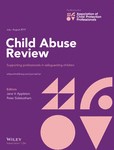 The latest issue of Child Abuse Review has just been published, with a special focus on child physical abuse. On the background of high media interest in child abuse, there is some research evidence that rates of more severe physical abuse may actually have decreased. This suggests that, perhaps, our societies are becoming less tolerant of physical violence towards children.
The latest issue of Child Abuse Review has just been published, with a special focus on child physical abuse. On the background of high media interest in child abuse, there is some research evidence that rates of more severe physical abuse may actually have decreased. This suggests that, perhaps, our societies are becoming less tolerant of physical violence towards children.
While we should celebrate this, there is certainly no cause for complacency. Marije Stoltenborgh and colleagues from the Centre for Child and Family Studies in Leiden have collated data from across the globe on all forms of maltreatment. They report that one in every five children globally report that they have experienced physical abuse during their childhood. While rates do vary between countries, these figures show that we still have a long way to go in protecting children from violence. One important finding from Stoltenborgh’s work, as with many other studies, is that the majority of physical abuse suffered by children never comes to the notice of professionals. Their data suggest that child protection services are only picking up one in every 75 cases of physical abuse. The implications are clear: we need to do better at recognising and responding to abuse, in providing children and young people with opportunities to tell someone about their experiences, and in supporting parents in bringing up their children without resorting to violence.
Professionals working in the child protection field do not have an easy job, and it is far too easy, when things go wrong, to blame the professionals for either not acting quickly enough, or for over-reacting and intervening inappropriately in families’ lives. In a previous paper, I have spoken of an evidence-informed approach to child protection: ‘the conscientious, explicit and judicious use of current best evidence, integrated with clinical expertise and an understanding of the context of the case, to guide decision making about the care of individual children.’ In order to do this, we need high-quality evidence from research and practice, combined with a good deal of common sense.
Other papers in this issue of Child Abuse Review provide some of that evidence: a case series of young children presenting with unexplained rib fractures (in which notably, all children diagnosed as having been abused had other features supporting that diagnosis, and all infants whose fractures were due to bone disease had other risk factors for that); and another case review of histories given by parents of children with abusive fractures (in all cases in their series, the accounts were often vague or uncertain, and frequently multiple accounts were given as the injuries came to light).
But that is where common sense and clinical skill need to come in. Child protection work is not straight forward: ‘While it may be possible to draw similarities between cases, and to highlight typical findings, the very nature of child maltreatment is such that complexity exists. While many cases may fit a classic presentation, others will not, and there can be multiple reasons for the manner in which cases present.’ I have previously argued that ‘Finding our way through this complexity requires an authoritative approach, combining a thorough understanding of the circumstances and context of the case, with an appraisal of the evidence base, the practitioner’s own expertise and experience, and the humility to work in partnership with children, their parents or carers, and other professionals.’
To see the contents and abstracts of this issue of Child Abuse Review, click here.
 Today is the last day of the BASPCAN Congress. Over the past three days I have had the privilege of meeting some awesome people from around the world – friends and colleagues old and new, united in one purpose: to make this world a better place for children. We have heard some inspiring talks, considered new research, and discussed novel ideas. It has been a really great congress.
Today is the last day of the BASPCAN Congress. Over the past three days I have had the privilege of meeting some awesome people from around the world – friends and colleagues old and new, united in one purpose: to make this world a better place for children. We have heard some inspiring talks, considered new research, and discussed novel ideas. It has been a really great congress.

